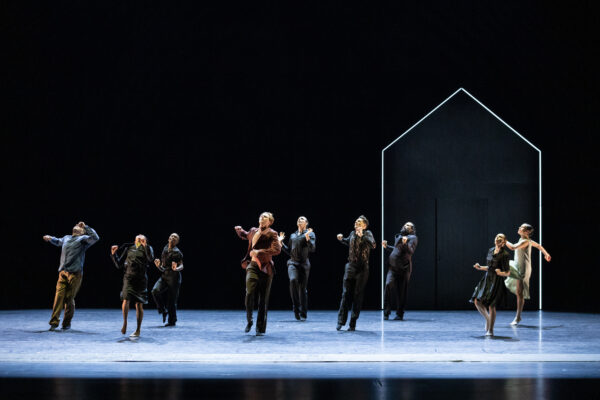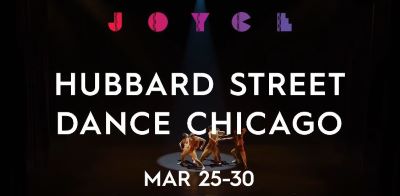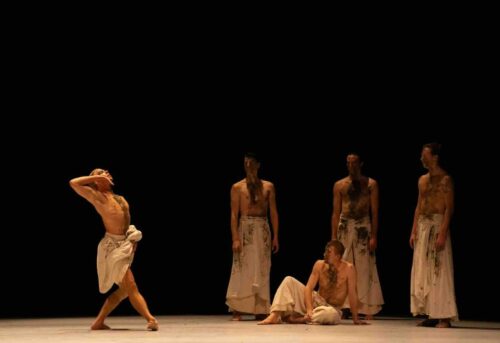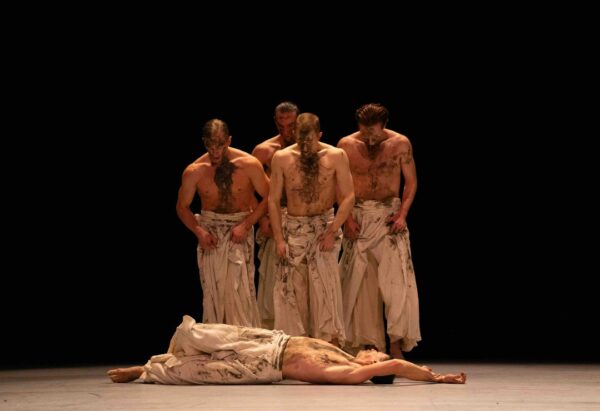HUBBA-HUBBA HUBBARD STREET
“It’s not magic, but it should seem like it is.” That advice came from a veteran jazz musician in the 1930s as he counseled a young aspiring player. In many ways, that nugget of truth applies to the world as dance as well. Closing in on its fifth decade, few contemporary dance companies in the country have sustained the illusion of magic within its art form as consistently, boldly or as successfully as Hubbard Street Dance Chicago (HSDC). While exceptional dance ability is essential, it is just one of the many distinguishing virtues of the company, which I have admired and touted for years. For Hubbard Street, its remarkable adaptability—a proficiency of shapeshifting—may be its most enduring and formidable superpower, and this week’s line-up at The Joyce NYC through Sunday typifies how well HSDC plays the part of consummate dance chameleons. Plus, we got three NY Premieres. By the end of a four-piece program, you will definitely understand its focus on entertainment, storytelling, and innovation, as the selected works span a vast creative spectrum—ranging from the mysterious to the delightfully playful.
Yet, at the beginning, I was a little dispirited by the first two numbers.
The first, Black Milk, is a tried-and-true work by Batsheva Company’s Ohad Naharin, which has lived many lives since its 1984 debut for the women of Kibbutz Contemporary Dance Company. It was restaged in 1990 for five men. Set to Paul Smadbeck’s minimalist marimba score, the piece hints at a story: four men cluster together, smearing themselves with black mud from a bucket (mud which my neighbor swore was actually from the Dead Sea!), while a lone figure hesitates before reluctantly following suit. Their copycat stillness-to-explosive movement conjures images of conformity and the relentless corporate grind, until the outsider—at last—washes himself clean (with water from the same bucket, in a bit of stagecraft magic) and reclaims his autonomy. The work ends as it began: the group huddled in one corner, the freethinker standing apart.
As restaged by Bret Easterling, what was once an intriguing ritual of the cleansing of some remote tribe now feels somehow obscure and, above all, lacked dynamism. Dancers Aaron Choate, Elliot Hammons, Jack Henderson, Andrew Murdock, and David Schultz formed a striking ensemble, their bare torsos and Japanese-style flowing pant-skirts the color of desert sand (by Rakefet Levy)—heightened by Avi Yona Bueno‘s bold lighting and Naharin’s unmistakable dynamic force—kept my attention. But the message, which should have been relevant, did not resonate.
And how strange to have a twenty-minute intermission after a 15-minute piece.
Next up was Into Being, choreographed by Alice Klock and Florian Lochner (FLOCK) for Hubbard Street Dance Chicago last year, unfolded with fluid intricacy, yet it felt too contemplative to leave a lasting impact—I found my mind wandering. The piece began with three dancers in a diagonal line stage left while two more entered slowly from down right, eventually merging into a collective. What followed was a series of solos and duets breaking away from the group, while the others marked time with synchronized gestures. Julie E. Ballard’s lighting precisely defined the space, creating boundaries the dancers subtly navigated, while Hogan McLaughlin’s identical costumes reinforced a sense of unity, as if the performers belonged to the same tribe. Michael Wall’s somber, meditative score underscored the introspective tone, but despite the seamless partnering and organic flow, the piece never fully commanded attention, its quiet beauty bordering on the ephemeral.
Hubbard Street Dancers Aaron Choate, Michele Dooley, Jacqueline Burnett, Cyrie Topete, and Simone Stevens in 'Into Being' by FLOCK. Photo by Michelle Reid
Hubbard Street Dancers Aaron Choate, Michele Dooley, Jacqueline Burnett, Cyrie Topete, and Simone Stevens in 'Into Being' by FLOCK. Photo by Michelle Reid
But then, after a pause, came a dynamite piece like a refreshing slap of cold water by one of my favorite choreographers, Aszure Barton. A Duo, also from last year, was a mesmerizing fusion of martial arts and dance, steeped in Japanese and Shaolin influences, yet deeply human at its core. Shota Miyoshi and Cyrie Topete, dressed in flowing pants and vests by Rémi van Bochove, moved through striking and astoundingly whimsical physical transformations—first as ancient, long-limbed figures, then as warriors whose movements blended Shaolin precision with Kabuki theatricality. Nicole Pearce’s geometric lighting carved out shifting spatial boundaries, subtly shaping the evolving dynamics of a relationship. Set to Marina Herlop’s Miu and Shaolin Mantis, where candy-coated female voices punctuated the pulsating score, the piece unfolded as a hypnotic dance of courtship, love, and sexual union. With mixed casting in alternating performances this weekend, Barton seems to be probing the universal forces that compel us toward connection and the challenges that come with it. This is the most original and fresh dance interpretation in recent memory—one that deserves a lasting place in Hubbard Street’s repertoire. And in the “you can’t fool an audience” department, the roar after this piece came from seeing a revelation.

Aszure Barton's A Duo. Photo by Michelle Reid
A thread of caution runs through Impasse, the fourth and final dance on the program. Choreographed by Johan Inger in 2020, that thread is only faintly suggested at the outset, revealing its full significance only in hindsight. It’s easy to get lost in its carnivalesque spectacle, it’s bigness and humor and the outlandish fun spilling from this full ensemble piece, which is yet another work HSDC dances to perfection. It’s an awesome carnival ride with a hidden warning, a riotous spectacle that dazzles with humor and theatricality before revealing its darker message.
Hubbard Street Dancers Jacqueline Burnett, Jack Henderson, and David Schultz in IMPASSE by Johan Inger. Photo by Michelle Reid.
Hubbard Street Dancers Jack Henderson, Jacqueline Burnett, and David Schultz in IMPASSE by Johan Inger. Photo by Michelle Reid
It begins innocently enough—a girl emerges from a neon-lit archway and twirls through an open world in her green dress, joined by, I assume, her boyfriend, and another friend. The trio’s playful skipping and hopping, set to the laid-back jazz trumpet of Ibrahim Maalouf, radiates youthful freedom. But then come six figures in black—cool, confident, seductive. One by one, the trio follows them through a door, only to return transformed, clad in black and moving in rigid unison. Their once-open house shrinks, their steps become confined, and the creeping weight of conformity sets in.

Hubbard Street Dance Chicago in IMPASSE by Johan Inger. Photo by Kristie Kahns.
Then the world cracks open. A grotesque carnival descends—a Vegas showgirl, and a creepy, all-too-familiar clown preside over the chaos as the dancers spiral into manic abandon, the sky quite literally collapsing around them. Maalouf’s pulsing rendition of They Don’t Care About Us drives the frenzy as the message lands with force: the world has become a nightmarish freak show, where progress feels impossible and the absurdity never ends (and there was talk afterwards about who the clown represented!). Even with a darker undertone, the piece was riveting and entertaining. Brilliantly, Impasse stops short of tipping into true madness—as if the dream is too vivid, too real, to wake up from. Hubbard Street Dance Chicago delivers it all to perfection, dancing with precision, abandon, and just the right amount of menace.
photos courtesy of Joyce Theater
Hubbard Street Dance Chicago
Joyce Theater, 175 Eighth Avenue
1-hour and 45-minutes, including two intermissions
see schedule here
ends on March 30, 2025
for tickets, visit Joyce




